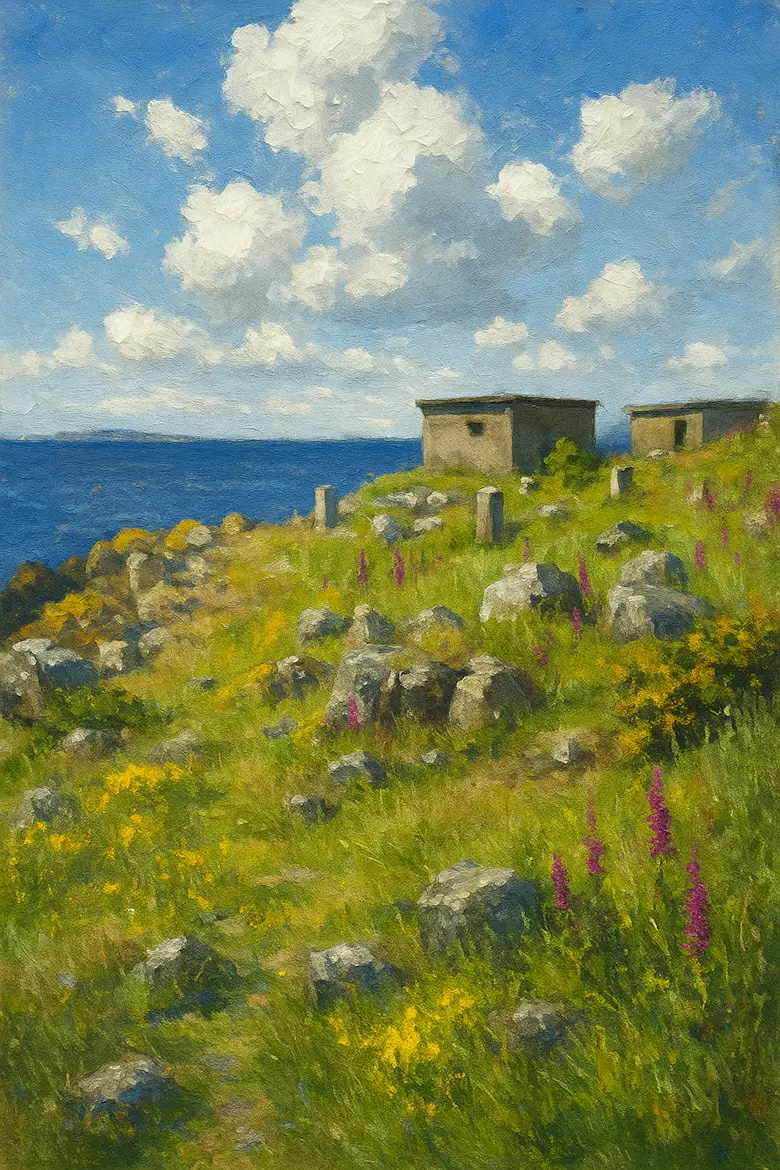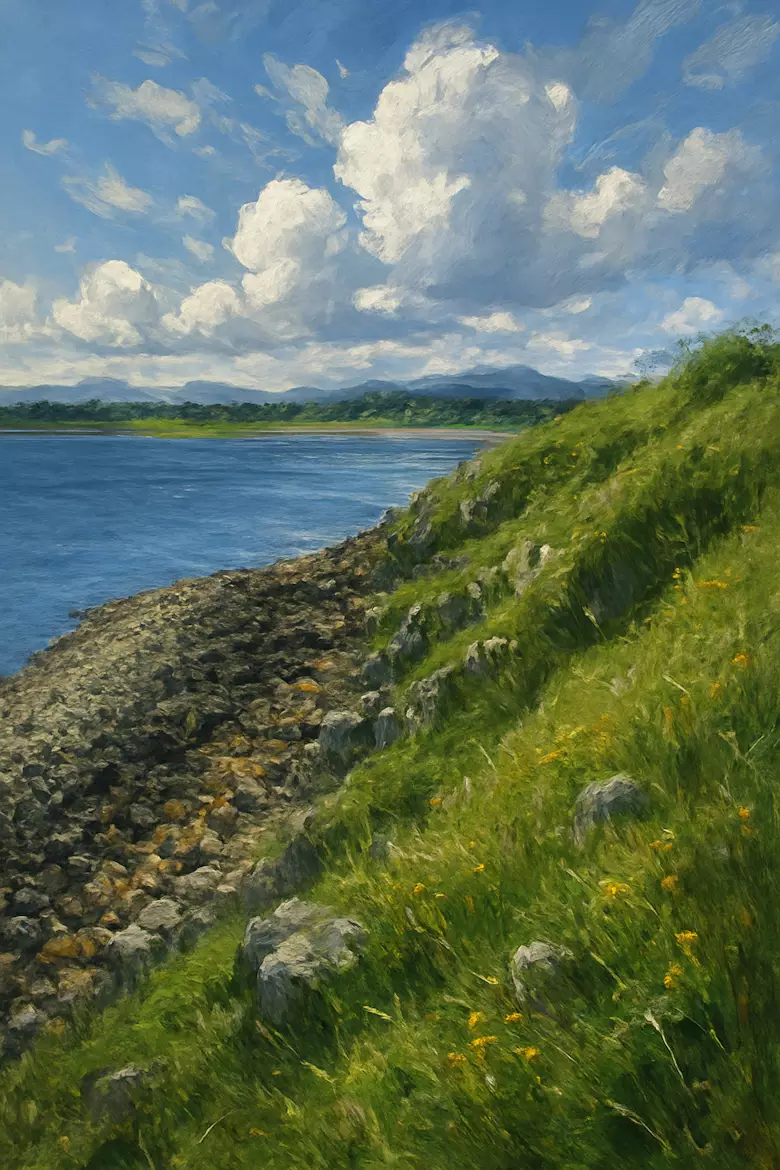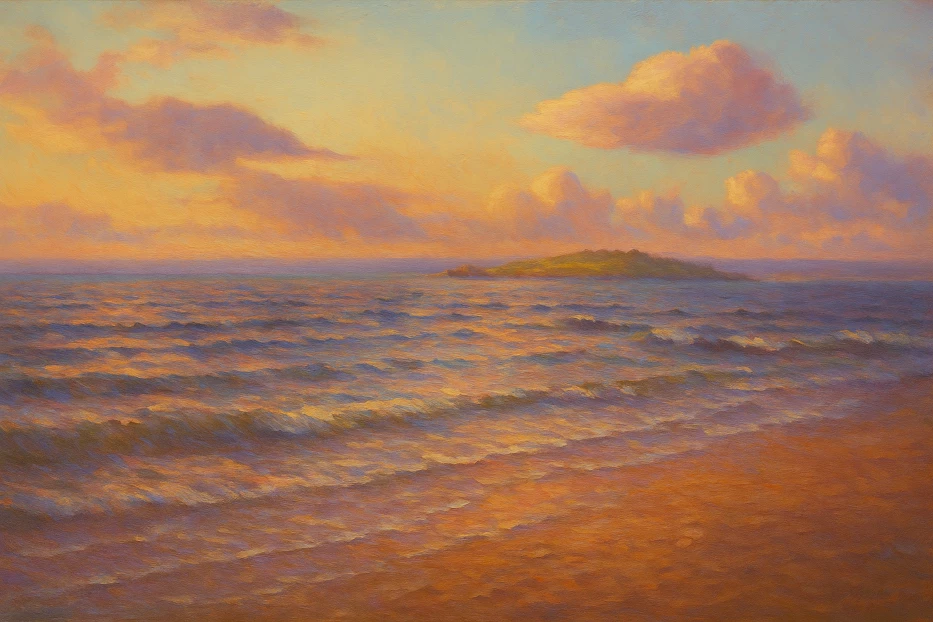For the curious traveler looking to step beyond the traditional Edinburgh checklist, Cramond Island offers adventure, history, nature, and a sense of discovery that’s gloriously low-key but richly rewarding.
Just several miles from the postcard spires of Edinburgh’s Old Town — where bagpipers soundtrack rush-hour and camera lenses tilt toward the castle — lies an entirely different Scotland. One of salt-air stillness, seabirds, and a tidal causeway that appears and vanishes with the moon. This is Cramond Island, a tiny tidal island on the Firth of Forth that feels like the city’s most poetic escape. It’s a place where you can walk across the seabed (yes, really), wander wartime ruins, skim stones in sight of ancient coastline, and still be back in central Edinburgh for dinner reservations.
Table of Contents
A Tidal Island Hiding in Plain Sight
Cramond Island sits just off the village of Cramond, an old fishing settlement north-west of Edinburgh. At first glance, especially if you arrive when the tide is high, the island feels unreachable and marooned behind a line of dramatic concrete pylons stretching across the water like the remnants of a dystopian film set.
But wait a few hours, and the sea quietly pulls back. A mile-long causeway reveals itself: barnacled, shimmering, and stretching across the Firth like an invitation to somewhere secret. Walking it is half the thrill: the crunch of seaweed beneath your shoes, the sea air sharpening the senses, the city skyline shrinking with each step.
This tidal access is the island’s magic and its most important caution. Visitors must check tide times (a local mantra you’ll see on signs and in every Edinburgh guidebook) so they don’t become part of the island’s many rescue tales. But time your crossing right, and it feels like nature’s own VIP pass.
The Allure: Why Cramond Island Captivates Travelers
Cramond Island isn’t a museum piece; it’s an exploration. Its charm lies in its contrasts:
- Wild yet easily accessible
- Peaceful yet layered with wartime history
- Rugged but perfect for a slow, scenic picnic
On clear days, locals bring dogs, paddleboards, and picnics; cyclists pause for sea views; artists set up tripods; and seabirds glide overhead. Even in moody weather (Scotland does atmosphere beautifully), there’s poetry in the swirling mist and the dramatic silhouette of the causeway defenses.
The view alone is worth the journey:
From the island, you can see the Forth Bridges, the coastline of Fife, and Edinburgh unfolding in the distance. It’s a panorama that rivals the city’s more famous viewpoints but feels like a personal discovery.
A Sense of Story: From Romans to World War II
Few places of this size hold as many layers of history as Cramond.
Roman Whispers
The village of Cramond is home to one of the most significant Roman sites in Scotland. Nearly 2,000 years ago, Romans raised a fort here at the mouth of the River Almond. The island would have been well within their eyeline — an outpost on the empire’s northern frontier. Artifacts discovered in the area tell tales of occupation, trade, and ancient settlement.
Medieval and Maritime Eras
The island later passed through centuries of use as farmland and for grazing livestock. Fishermen used it. Smugglers, perhaps, exploited its tides. Those who grew up near Cramond often recall childhood summer adventures here: camping, rock-pooling, exploring its edges with a thrill of independence.
World War II Ruins
The most visible evidence of history today belongs to the 20th century. The row of concrete pylons that flank the causeway was built during World War II to prevent enemy craft from slipping between the island and mainland; lookout posts and shelters remain on the island itself. Wander them, and you’ll feel the ghosts of vigilance, salt-rusted metal, and a coastline once armed against threat.
They lend the landscape a haunting beauty: nature reclaiming history in slow, poetic motion.

The Walk: What to Expect on Your Visit
Cramond Island doesn’t require a trek, but it rewards taking your time.
Start in Cramond Village
Begin your visit in the charming waterfront village, where whitewashed cottages meet riverside paths. Grab a coffee and pastry from a local café or enjoy fish and chips by the shore. A promenade leads towards the causeway, typically dotted with walkers, dogs, and cyclists.
Crossing the Causeway
The walk from mainland to island takes around 15 minutes, with the pylons on one side and the open sea on the other. At low tide, tidal pools teem with marine life — keep an eye out for crabs, sea anemones, and seabirds hunting for food.
Exploring the Island
Once across, the island is yours to roam. There are no facilities and no formal paths, just grassy patches, rocky beaches, WWII shelters, and spectacular sea views. Circle the island if the tide is safely out; climb gently to the island’s highest ground for the best vantage point.
Most visits last 1.5–3 hours, including crossing time. Many pair the island with a longer coastal walk, cycle ride, or riverside trail through the nearby Cammo Estate.
The Tides: Beauty with Boundaries
The tides around Cramond Island are no joke — fast, powerful, and unforgiving. Many visitors underestimate the speed at which water returns, cutting off the causeway long before the waves appear from the open sea.
Essential guidance:
- Check tide times before setting off (search “Cramond Island tide times” online or use local boards).
- Allow a minimum 2-hour safety window for your return.
- If in doubt, wait for full low tide.
This isn’t to scare you, just to ensure your trip stays magical, not memorable for the wrong reasons. Done right, the tide adds to the allure; it imposes a gentle rhythm that makes the trip feel intentional, even ritualistic.
Season by Season: The Best Time to Visit
Spring brings bright light, seabirds nesting, and green coastal growth. It’s ideal for photography.
Summer is most popular: picnicking, paddling, and long golden hours. Expect company, especially on sunny weekends—though the island rarely feels crowded.
Autumn paints the coastline in russet tones and offers dramatic skies. It’s a photographer’s dream and arguably the most atmospheric season.
Winter is for the hardy and romantic — roaring winds, dramatic waves, and an almost monastic quiet. Dress warmly, and plan your tides carefully; daylight hours are short.
What Makes Cramond Island a “Value” Experience
It’s free. Entirely free.
No admission, no ferries, no bookings, just the gift of time and tide. For budget-minded travelers, families, solo explorers, and anyone looking to expand their Edinburgh itinerary without extra cost, Cramond Island delivers exceptional value.
But “value” here is more than financial:
- It feels like a hidden local secret.
- It offers a half-day adventure with minimal planning.
- It balances Edinburgh’s urban richness with space, air, and calm.
It’s rare to find a city where you can go from medieval pubs and Michelin-star dinners to exploring a tidal island on foot: all in the same day. Cramond Island is that rare travel alchemy: authentic, storied, photogenic, and completely accessible.
For Photographers & Dreamers
Cramond Island is a moodboard waiting to happen.
At sunrise, the causeway glows, and the sea mirrors the sky.
At sunset, silhouettes of pylons cut striking lines against a pink-lavender horizon.
Misty days lend an ethereal, cinematic feel — perfect for drone footage (mind local regulations).
It’s no wonder fashion shoots and local filmmakers are increasingly using the causeway as a set; there’s drama in every frame.
Sustainability & Respect: Visiting with Care
As travel increasingly values slow, mindful, environmentally conscious experiences, Cramond Island stands as a natural fit. To preserve its wild charm:
- Leave no trace: bring your rubbish back with you.
- Stick to safe paths and avoid disturbing nesting birds.
- Respect the wartime structures — don’t climb or damage them.
There are no facilities on the island, and that’s part of the charm. It feels untouched, so let’s keep it that way.

How to Get There
From Edinburgh city centre, reach Cramond in about 30–40 minutes:
Bus: Lothian Buses from the city centre (often 41, route changes possible).
Car: About 20 minutes; limited parking available near the waterfront.
Cycle: A scenic route via NCN Route 1 or coastal cycle paths.
Once there, follow the promenade to the causeway and check those tide times one final time before you set off.
Who Will Enjoy Visiting Cramond Island?
Couples seeking a romantic, off-beat experience.
Solo travelers wanting a reflective walk.
Families (adventure with a gentle dash of thrill).
History buffs tracing Edinburgh’s untold stories.
Nature enthusiasts and wildlife spotters.
Photographers, artists, and writers craving inspiration.
If you prefer your travel with a touch of wonder and a sense of discovery, Cramond Island quietly exceeds expectations.
Cramond Island: Edinburgh’s Most Underrated Adventure
In a city known for festivals, heritage, nightlife, and architectural grandeur, it’s easy to stay within the postcard frame. But the magic of Edinburgh isn’t only in its monuments, it’s in the surprising layers of landscape and experience that lie just beyond.
Cramond Island is Edinburgh’s invitation to slow down, breathe in the sea air, and step into a journey determined not by schedules, tours, or queue times but by the moon-pulled tide itself.
It’s a small adventure with a generous spirit; a momentary escape that lingers in memory long after your shoes have dried.
And most of all, it delivers a rare value: a travel experience that feels both intimate and extraordinary, at no cost but the time you choose to give it.

